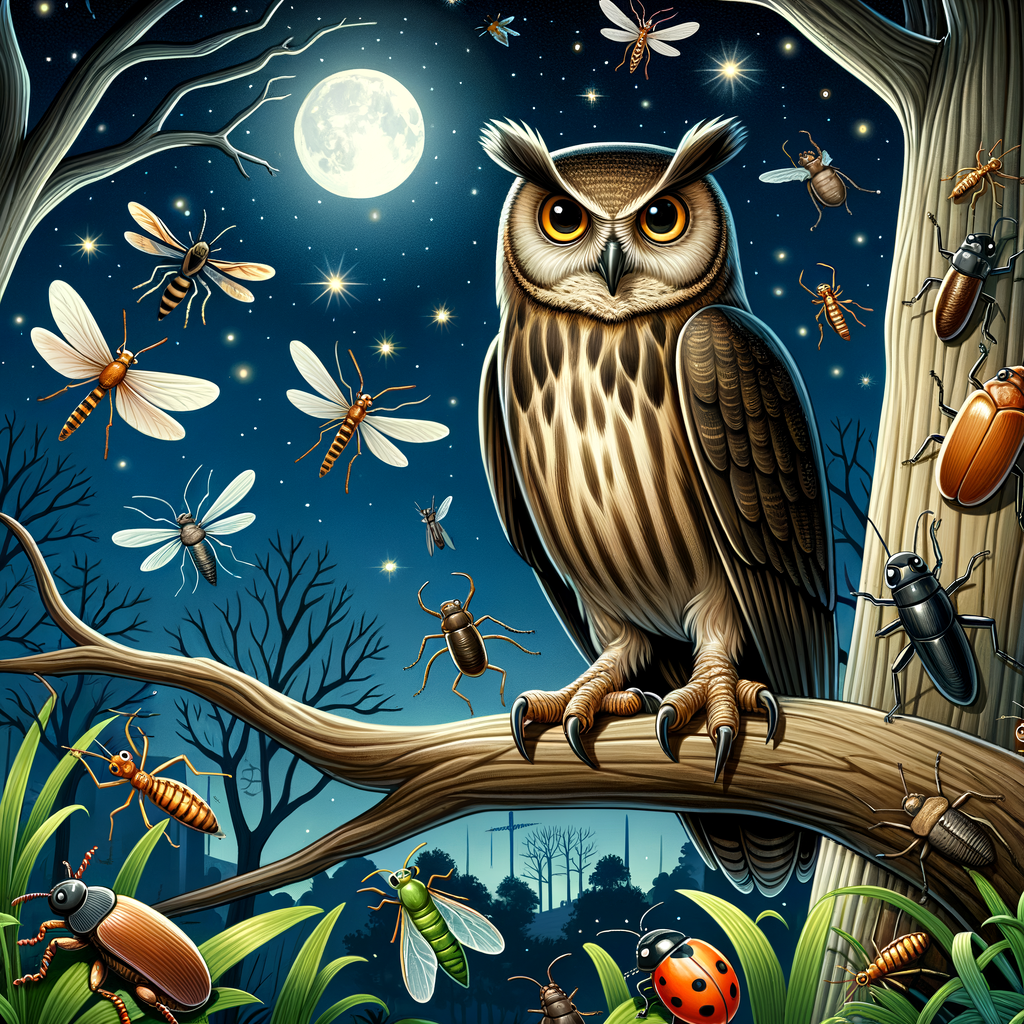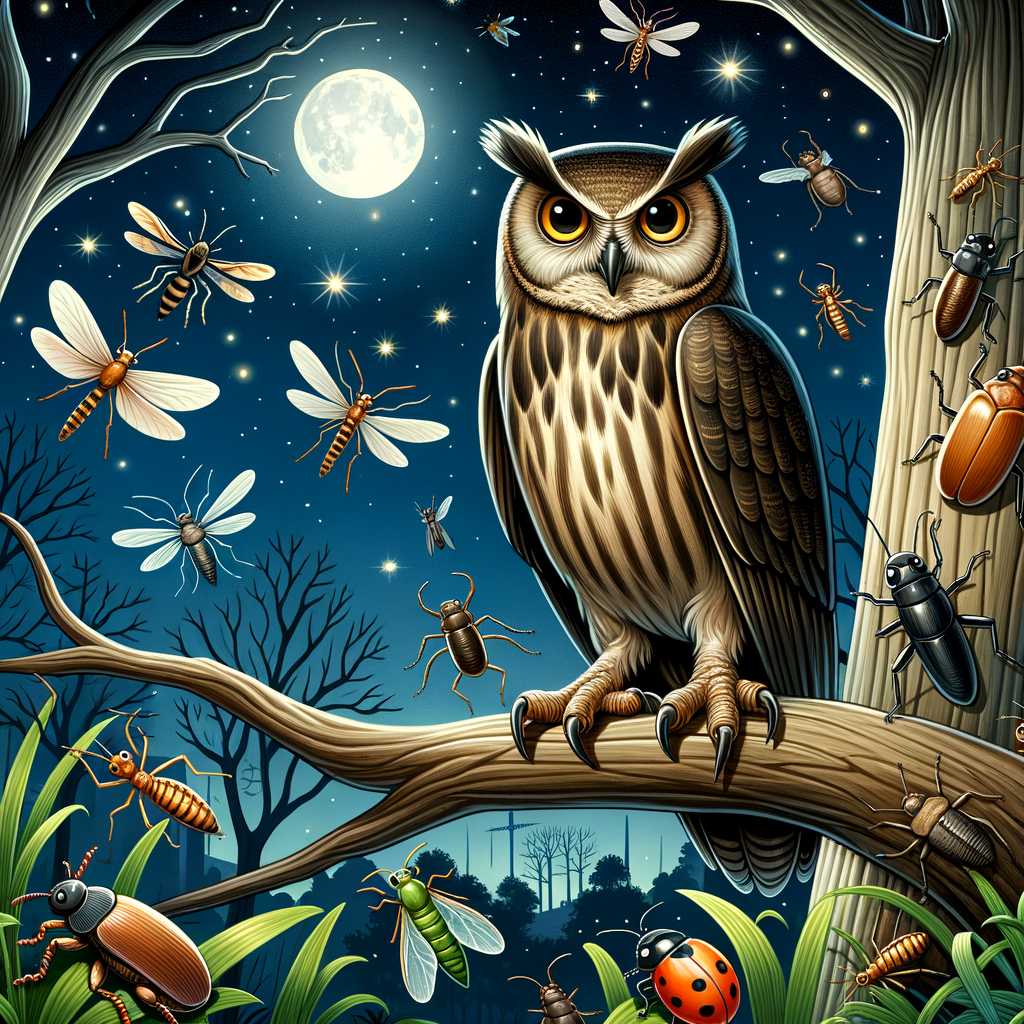
Owls: Nature’s Silent Pest Controllers
Introduction to Owls and Insect Control
- The ecological role of owls: Owls play a vital role in nature. They help keep the balance in ecosystems by controlling the population of insects and small animals. Owls hunt at night, using their sharp vision and silent flight to catch prey.
- Overview of owls as pest controllers: Owls are excellent pest controllers. They eat many insects that can harm crops and gardens. By keeping the insect population down, owls help farmers and gardeners. This natural pest control reduces the need for harmful chemicals.
Owl Predation on Insects
How Owls Hunt Insects
-
- Owls’ hunting techniques
They use their sharp talons to catch insects. Owls also have excellent night vision, which helps them see in the dark. They can hear the slightest sounds, allowing them to locate insects even when they are hidden.
-
- Adaptations that aid in insect hunting
Their feathers are designed to make their flight silent. This way, they can sneak up on their prey without being heard. Additionally, their beaks are strong and curved, perfect for catching and eating insects.
Common Prey of Owls
-
Types of Insects Commonly Eaten by Owls
Owls are known to eat a variety of insects. Some of the most common types include:
- Beetles: Many owl species, like the Barn Owl, often hunt beetles.
- Moths: Owls such as the Screech Owl frequently catch moths.
- Grasshoppers: These insects are a favorite for owls like the Burrowing Owl.
- Crickets: Crickets are another common prey for many owl species.
-
Impact of Owl Predation on Insect Populations
Owls play a crucial role in controlling insect populations. Here are some key impacts:
- Population Control: By eating large numbers of insects, owls help keep these populations in check.
- Ecological Balance: Help maintain balance in ecosystems by preventing insect overpopulation.
- Reduction of Pests: Reduce the number of pests that can damage crops and spread diseases.
For example, a single Barn Owl can eat up to 1,000 insects in one year. This helps farmers by reducing the need for chemical pesticides.
Natural Pest Control by Owls
Benefits of Owls in Agriculture
- Case study: Owls reducing insect populations in a farm settingIn a farm in California, barn owls were introduced to help control pests. Over a year, the owl population grew, and the number of harmful insects dropped by 60%. This helped the farm produce healthier crops without using chemicals.
- How owls contribute to pest management in agriculture4FEThey eat many insects that can damage crops. By having owls around, farmers can reduce the need for pesticides. This is good for the environment and saves money.
Owls and Ecosystem Balance
- The role of owls in maintaining ecological balance:
Owls play a crucial role in keeping ecosystems healthy. They are top predators, meaning they help control the populations of other animals. This balance is important because it prevents any one species from becoming too numerous and causing problems. For example, by eating rodents, owls keep their numbers in check, which helps protect crops and reduce the spread of diseases. - Effects of owls on other pest populations:
Many owls eat insects like beetles and moths. This is especially helpful for farmers, as these insects can damage crops. By reducing the number of pests, owls help farmers grow more food without needing as many chemical pesticides. This natural pest control is both eco-friendly and cost-effective.
| Owl Species | Primary Prey | Habitat |
|---|---|---|
| Barn Owl | Rodents | Farmlands, grasslands |
| Great Horned Owl | Small mammals, insects | Forests, deserts |
| Eastern Screech Owl | Insects, small birds | Woodlands, suburban areas |
According to Wikipedia, owls are found on every continent except Antarctica. They are known for their silent flight and excellent hunting skills. By keeping pest populations in check, owls help maintain a healthy and balanced ecosystem.
Insect-Eating Owls: Species and Habitats
Species of Insect-Eating Owls
- Overview of owl species known for insect control:These include the Barn Owl, Eastern Screech Owl, and the Elf Owl. Each of these owls plays a vital role in keeping insect numbers in check.
Owl Species Primary Insects Eaten Barn Owl Moths, beetles, and grasshoppers Eastern Screech Owl Crickets, moths, and beetles Elf Owl Scorpions, moths, and beetles - Characteristics of insect-eating owls:For example, the Elf Owl is the smallest owl in the world, allowing it to catch tiny insects easily. The Barn Owl has excellent night vision and silent flight, making it a stealthy predator.
These owls also have specialized feathers that help them fly quietly. This silent flight helps them sneak up on their prey without being detected. Additionally, their sharp talons and beaks are perfect for catching and eating insects.
Habitats of Insect-Eating Owls
- Common habitats of insect-eating owlsThese include forests, grasslands, deserts, and even urban areas. Each habitat offers unique opportunities for these owls to find food and shelter.
Habitat Examples of Owls Forests Eastern Screech Owl, Barred Owl Grasslands Burrowing Owl, Short-eared Owl Deserts Elf Owl Urban Areas Barn Owl - How these habitats contribute to their role as pest controllersEach habitat helps owls control insect populations in different ways. In forests, owls keep tree-damaging insects in check. In grasslands, they control pests that harm crops. In deserts, they manage insects that can spread diseases. Even in cities, owls help by eating bugs that invade homes.
For example, the Barn Owl is known for living in urban areas and helps control rodent and insect populations. This makes them valuable allies in maintaining a balanced ecosystem.
Conclusion: The Importance of Owls in Pest Control
Owls play a vital role in controlling insect populations. They help keep our environment balanced and healthy. Here are some key points to remember:
-
Key takeaways on the role of owls in insect control:
- Owls eat many insects that can harm crops and gardens.
- They help reduce the need for chemical pesticides.
- Owls are natural predators, making them an eco-friendly solution.
-
The future of natural pest control by owls:
- More people are recognizing the benefits of owls in pest control.
- Conservation efforts are helping to protect owl habitats.
- Using owls for pest control can lead to healthier ecosystems.
Owls are more than just fascinating birds. They are essential for natural pest control. By supporting owl populations, we can enjoy a cleaner and greener environment.
| Benefits of Owls | Details |
|---|---|
| Natural Pest Control | Owls reduce the need for harmful pesticides. |
| Eco-Friendly | Owls help maintain a balanced ecosystem. |
| Cost-Effective | Using owls can save money on pest control. |
For more information on owls and their role in pest control, you can visit Wikipedia.






